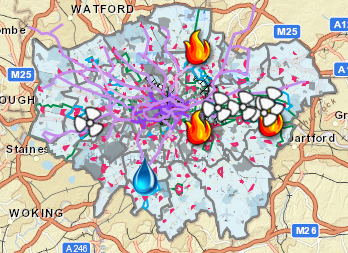23 February 2016: The GLA launched the first outputs from their forthcoming London Energy Plan (LEP) at an event held at the The Crystal. The purpose of the LEP is to support the development of the London Infrastructure Plan by evaluating London’s future energy needs to 2050, as a result of a rapidly increasing population (approximately 100,000 people a year) and the predicted increase in energy demand as a result of this growth. Further background to the London Energy Plan can be seen on the following presentations here and here.
As part of this work, the GLA have built on previous work in establishing a London Heat Map, to develop the first spatial mapping of London’s energy demand, supply and infrastructure. The interactive map allows different scenarios for energy supply and demand across London in 2015, 2025 and 2050 to be explored (in that, it is similar to DECC’s 2050 Energy Calculator). The London Energy Plan map can be accessed here.
The London Energy Plan looks at four scenarios for the city’s energy infrastructure to 2050:
• High demand, centralised supply
• Mid demand, mixed supply
• Low demand, decentralised supply
• Low demand, centralised supply.
An accompanying Scenarios to 2050 narrative document (direct download here) provides the detail and context to the assumptions made across these scenarios. Two key messages that came out of the event was that for London to achieve its longer term energy and carbon goals, there was an urgent need to start planning and to act now. Additionally, the highest amount of effort in terms of energy and emissions reductions needed to be achieved over the next decade – something that an incoming Mayor in May 2016 will need to address.
The GLA’s modelling work has been supported by the following studies commissioned by the Mayor:
| AECOM | Developing an energy demand model for domestic and non-domestic buildings in London until 2050 | ||
| Element Energy | Developing models that estimate: power demand and generation in London until 2050; and potential for heat networks in London until 2050 | ||
| Buro Happold | Developing a model to estimate the potential for solar PV until 2050 |
Presentations delivered by the GLA at the event (not available as yet) provided details around some of the initial results of this modelling work, which included:
- The ‘Low demand, decentralised supply’ scenario provide the greatest reduction in London’s energy demand by 2050 – a near 30% reduction compared to a 2015 baseline.
- Similarly, London can only meet its 2050 80% carbon reduction target under the ‘Low demand, decentralised supply’ scenario
- The ‘Mid demand, mixed supply’ scenario delivered the highest volume of PV in London – close to 170,000 installs by 2050
- London cannot meet its 2050 carbon targets under a centralised scenario without significant building retrofit
- The capital costs for London to achieve its carbon and energy targets ranged between £50 bn to £100 bn across the different scenarios
- This compares to the £1.3 trillion estimated required for London across all infrastructure needs to 2050 (as is set out in the London Infrastructure Plan – see here for details)
- Under the ‘High demand, centralised supply’ scenario – London would need to have 1.5 million heat pumps in place.
No timeline was given as to when the final London Energy Plan will be published, or whether the findings from this work were to be consulted upon. The GLA did however state that the LEP Advisory Group set in place to help support the development of the spatial map will remain in place for the time being.


